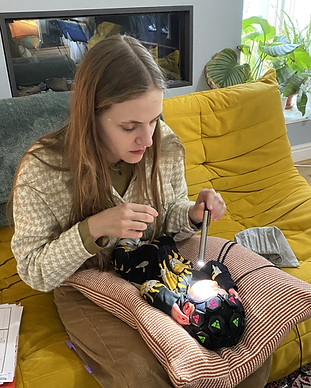Learning from your baby and family's journey
Study Purpose
PIPKIN Participation Video
Before they are born, do babies react differently to speech than other noises in the womb?
How do newborn babies learn what is important, focusing on relevant sounds and objects?
How do parents help their babies recognize the range of human-like faces and voices?

An empirical snapshot of your unique baby
Participation Timeline

Welcome
20+ weeks: Questionnaires
~30 weeks: 4D Ultrasound 1
33+ weeks: 4D Ultrasound 2

Congratulations!
Week 1: Home Visit 1
Week 2: Home Visit 2
1 Month: Home Visit 3

Your Growing Baby
2-4 months: Home Recording
~5 months: Lab Visit 1
5-6 months: Lab Visit 2
Our Imaging Approaches

4D ultrasound collects a time-stamped video of your baby in the womb, allowing healthcare specialist and researchers to record a video of your baby's movements. Like other ultrasound scans, 4D ultrasound uses high-frequency sound waves to generate images of organs and tissues inside the body. These sound waves are emitted by a special probe scanned by the sonographer, an NHS employee at the Rosie Maternity Hospital.

Just after your baby is born, we use Functional Near-Infrared Spectroscopy (fNIRS) to record optical neuroimaging and analyse your newborn's localised brain activation. Our neonatal LUMO system is custom-made by Gowerlabs to measure absorption of near infrared light within different areas of the brain in response to stimuli. The more light is absorbed, the more oxygen is being used within an area, which indicates neural activity. Near infrared light can capture distinct characteristics of oxy- and deoxy-haemoglobin concentration changes.

Even at one month of age, your baby's brain cells (neurons) generate electrical activity which is difused to the surface of their head. We can passively record the changes in the charge of many neurons even while your baby sleeps peacefully using a wireless infant electroencephalography (EEG) system. The EEG signals are enhanced by gel electrodes that are placed in a stretchy cap. Our system, a portable, wireless Enobio 20-channel cap is tailored for babies' small heads.

Neonatal Behavioural Assessment Scale is a tool that lets us listen to the baby’s voice right from birth through observing their behaviour and unique communication cues. Understanding baby’s early social signals and interpreting them along with parents gives us a glimpse to their emerging personality and preferences.
The scale involves presenting your baby with objects to interact with when awake and sounds (such as ringing a bell) as they sleep to observe their responses and reactions to a range of experiences.

Our 'Babeyes' Home Recording visit lets us envision the world through the eyes of a 2-4 month old, learning from daily social interactions and absorbing their naturalistic home surroundings. While we record babies' reactions to what they see and hear using the LENA (Language ENvironment Analysis) voice recorder, Babeyes head-strapped camera and a heart rate monitor (echocardiogram or ECG).

Mullen Scales of Early Learning is a task that highlights children's motor, language and visual skills through a set of interactive games. A researcher engages your child with blocks, peak-a-boo and tummy time tasks to learn how refined their abilities relative to their age and parents also report on their child's vocalizations and reactions.
Learn more about the fellowship and purpose of the PIPKIN study
Learn more about CoCoPIP's purpose and insight into 'Generation COVID'
Learn how our CoCoPIP study provided insight into the concerns of new and pregnant parents during the pandemic

Neonatal Behavioural Assessment Scale is a tool that lets us listen to the baby’s voice right from birth through observing their behaviour and unique communication cues. During each newborn home visit, our certified 'baby whisperer' researchers will interact with your newborn at home, eliciting a range of different reactions to sound, objects and faces. Our approach is to tailor the tasks for babies' state, so we can highlight the skills and strengths of even a sleeping baby or exploit their brief windows of alertness.

To capture a "day in the life" through the eyes of a baby, a home recording visit when your baby is 3-4 months old. Your baby will be outfitted with 'science-style' clothing that record what your baby sees, hears, and reacts to. Equipment built specifically to monitor babies activities and responses comfortably all day long is sewn in, including a "Babyeyes" camera attached to a little hat, a language recording "LENA" device and an electrocardiogram (ECG) to record heart rate variability.

The Mullen Scales of Early Learning let us see how much your little one's motor, language and visual skills have matured through a set of interactive games and standard tasks during the lab visits. We also track babies’ movements and gaze throughout an interaction with their parents at 1 and 5 months using software and our expert coders to identify interesting behaviors that children use to soothe themselves and explore their environments, and moments of synchrony between parent and child.

